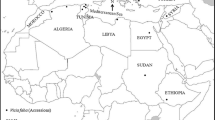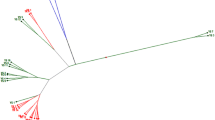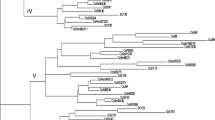Abstract
Use of molecular markers such as Random Amplified Polymorphic DNA (RAPD), Amplified Fragment Length Polymorphism (AFLP) and Simple Sequence Repeats (SSR) as descriptors to characterize and differentiate a set of 100 soybean varieties of commercial use in Argentina was taken as a leading case study for plant variety protection (PVP) purposes. Sixteen morphological traits were recorded to compare pedigree relationships among varieties with information derived from conventional descriptors and molecular markers. Analysis of 109 polymorphic loci confirmed the rather low genetic variability of commercial soybean germplasm. Still, genetic fingerprinting of the 100 varieties could be established. Calculated similarity indexes were dependent on the technique, ranging from 0.262 (SSR), 0.407 (RAPD), 0.400 (AFLP) and 0.574 (morphological traits).Dendrograms generated from morphological data matrix showed low value correlation with kinship coefficient matrix (r = 0.216). Still, they were suitable to identify and differentiate each of the 100 varieties analyzed; which was not possible with RAPD or AFLP markers using comparable numbers of polymorphic loci. SSR data showed the best fit to pedigree information (r = 0.353), while maintaining an association to morphologically based separation. Results suggest that the four techniques describe genetic variability in different and specific ways. A combination of SSR and morphological descriptors show the best compromise of regarding genetic relationships and the needs of clear classification for PVP and may help to establish minimum genetic distances for distinctness within PVP Office definition.
Similar content being viewed by others
References
Ajmone-Marsan, P., P. Castiglioni, F. Fusari, M. Kuiper & M. Motto, 1998. Genetic diversity and its relationship to hybrid performance in maize as revealed by RFLP and AFLP markers. Theor Appl Genet 98: 219–227.
Akkaya, M.S., R.C. Shoemaker, J.E. Specht, A.A. Bhagwat & P.B. Cregan, 1995. Integration of simple sequence repeats (SSR) DNA markers into a soybean linkage map. Crop Sci 35: 1439–1445.
Anderson, J.A., G.A. Churchill, J.E. Autrique, S.D. Tanksley & M.E. Sorrells, 1993. Optimizing parental selection for genetic linkage maps. Genome 36: 181–186.
Barret, B.A. & K.K. Kidwell, 1998. AFLP-based genetic diversity assessment among wheat cultivars from the Pacific Northwest. Crop Sci 38: 1261–1271.
Becker, J., P. Vos, M. Kuiper, F. Salamini & M. Heun, 1995. Combined mapping of AFLP and RLPS markers in barley. Mol Gen Genet 249: 65–73.
Brown, S.M., M.S. Hopkins, S.E. Mitchell, M.L. Senior, T.Y. Wang, R.R. Duncan, F. Gonzalez-Candelas & S. Kresovich, 1996. Multiple methods for the identification of polymorphic simple sequence repeat (SSRs) in sorghum [Sorghum bicolor (L.) Moench]. Theor Appl Genet 93: 190–198.
Cervera, M.T., J. Gusmao, M. Steenackers, J. Peleman, V. Storme, A. Vanden Broeck, M. Van Montagu & W. Boerjan, 1996. Identification of AFLP molecular markers for resistance against Melanospora larici-populina in Populus. Theor Appl Genet 93: 733–737.
Clifford, H.T. & W. Stephenson, 1975. An Introduction to Numerical Classification, Academic Press, New York, 229 pp.
Cregan, P.B., 1999. SoyBase Home Page (http://129.186.26.94/SSR.html).
Crisci, J.V. & M.F. López Armengol, 1983. Introducción a la Teoría y Práctica de la Taxonomía Numérica. Secretaría General de la Organización de los Estados Americanos. Programa Regional de Desarrollo Científico y Tecnológico, Washington, D.C., 132 pp.
Diwan, N. & P.B. Cregan, 1997. Automated sizing of fluorescentlabeled simple sequence repeats (SSR) markers to assay genetic variation in soybean. Theor Appl Genet 95: 723–733.
Domini, P., J.R. Law, R.M.D. Koebner, J.C. Reeves & R.J. Cooke, 2000. Temporal trends in the diversity of UK wheat. Theor Appl Genet 100: 912–917.
Dos Santos, J.B., J. Nienhuis, P. Skroch, J.G. Tivang & M.K. Slocum, 1994. Comparison of RAPD and RFLP genetic markers in determining genetic similarity among Brassica oleracea L. genotypes. Theor Appl Genet 87: 909–915.
Giorda, L. & H. Baigorri, 1997. El cultivo de la soja en Argentina. INTA. Centro Regional Córdoba. EEA Marcos Juárez-EEA Manfredi. Coordinación Subprograma Soja. 448 pp.
González, H.R., INASE, 1999. National Seed Institute, Yearbook, Estilos Gráficos S.A. Publisher, Buenos Aires-Argentina. 84 pp.
Kein, P., W. Beavis, J. Schupp & R. Freestone, 1992. Evaluation of soybean RFLP marker diversity in adapted germplasm. Theor Appl Genet 85: 205–212.
Liu, J.-J. & J. Kuo, 1995. Novel PCR-Based Assay for plant and Bacterial DNA Fingerprinting. Focus 17: 66–70.
Lodhi, M.A., G.-N. Ye, N.F. Weeden & I. Reisch, 1994. A simple and efficient method for DNA extraction from grapevine cultivars and vitis species. Plant Mol Biol 12: 6–13.
Manifesto, M.M., A.R. Schlatter, H.E. Hopp, E.Y. Suarez & J. Dubcovsky, 2001. Quantitative evaluation of genetic diversity in wheat germplasm using molecular markers. Crop Sciences 41 (in press).
Mantel, N., 1967. The detection of disease clustering and a generalized regression approach. Cancer Res 27: 209–220.
Maughan, P.J., M.A. SaghaiMaroof & G.R. Buss, 1995. Microsatellite and amplified sequence length polymorphisms in cultivated and wild soybean. Genome 38: 715–723.
Milbourne, D., R. Meyer, J.E. Bradshow, E. Baird, N. Bonar, J.W. Powel, M. Morgante, C. Andre, M. Hanafey, M. Vogel, S.V. Tingey & J.A. Rafalsky, 1997. Comparison of PCR-based marker systems for the analysis of genetic relationships in cultivated potato. Mol Breed 3: 127–136.
Powell, J.W., M. Morgante, C. Andre, M. Hanafey, M. Vogel, S.V. Tingey & A. Rafalski, 1996. The comparison of RFLP, RAPD, AFLP and SSR (microsatellite) markers for germplasm analysis. Mol Breed 2: 225–238.
Rohlf, F.J., 1992. NTSYS-pc. Numerical taxonomy and multivariate analysis system version 1.7 Exeter Publ.LTD Setauket, NY.
Rongwen, J., M.S. Akkaya, A.A. Bhagwat, U. Lavi & P.B. Cregan, 1995. The use of microsatellite DNA markers for soybean genotype identification. Theor Appl Genet 90: 43–48.
Sambrook, J., E.F. Fritsch & T. Maniatis, 1989. Molecular Cloning. A laboratory manual. 2nd. Ed. Cold Spring Harbor Laboratory Press, New York.
Sharma, S.K., M.R. Knox & T.H.M. Ellis, 1996. AFLP analysis of the diversity and phylogeny of Lens and its comparison with RAPD analysis. Theor Appl Genet 93: 751–758.
Smith, S. & E. Chin, 1992. Pioneer Hi-Bred International. Application of RAPD Technology to Plant Breeding. Joint Plant Breeding Symposia. Minneapolis, Minnesota, EUA. 46-49 pp.
Smith, S. & J. Register, 1998. Genetic purity and testing technologies for seed quality: a company perspective. Seed Sci Res 8: 285–293.
Smith, S. & J. Registrer, 1998. Genetic Purity and Testing Technologies. DNA-based methodologies replace biochemistry. PROPHYTA, ISTA Congress OECD, Pretoria, South Africa. 50- 53 pp.
Sneath, P.H.A. & R.R. Sokal, 1973. Numerical Taxonomy. The Principles and Practice of Numerical Classification, Freeman, San Francisco, CA., XV, 573 pp.
Tautz, D., M. Trick & G.A. Dover, 1986. Cryptic simplicity in DNA is a major source of genetic variation. Nature 322: 652–656.
Thormann, C.E., M.E. Ferreira, L.E.A. Camargo, J.G. Tivang & T.C. Osborn, 1994. Comparison of RFLP and RAPD markers to estimating genetic relationships within and among cruciferous species. Theor Appl Genet 88: 973–980.
Tinker, N.A. & D.E. Mather, 1993. KIN: software for computing kinship coefficients. J Heredity 84: 238.
UPOV/TG/80/3, 1983. Guidelines for the Conduct of Test for Distinctness, Homogeneity and Stability, Soybean (Glycine max (L.) Merrill).
Vos, P., R. Hogers, M. Bleeker, M. Reijans, T. Van de Lee, M. Hornes, A. Frijters, J. Pot, J. Peleman, M. Kuiper & M. Zabeau, 1995. AFLP: a new technique for DNA fingerprinting. Nucl Acids Res 21: 4414–4470.
Welsh, J. & M. McClelland, 1990. Fingerprinting genomes using PCR with arbitrary primers. Nucl Acids Res 18: 7213–7218.
Williams, J.G.K., A.R. Kubelik, K.J. Livak, J.A. Rafalsky & S.V. Tingey, 1990. DNA polimorphisms amplified by arbitrary primers are useful as genetic markers. Nucl Acids Res 18: 6331–6336.
Author information
Authors and Affiliations
Rights and permissions
About this article
Cite this article
Giancola, S., Marcucci Poltri, S., Lacaze, P. et al. Feasibility of integration of molecular markers and morphological descriptors in a real case study of a plant variety protection system for soybean. Euphytica 127, 95–113 (2002). https://doi.org/10.1023/A:1019923923805
Issue Date:
DOI: https://doi.org/10.1023/A:1019923923805




